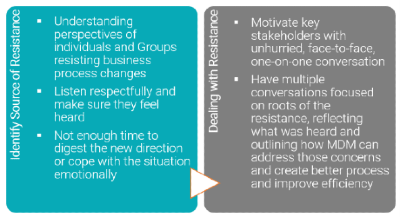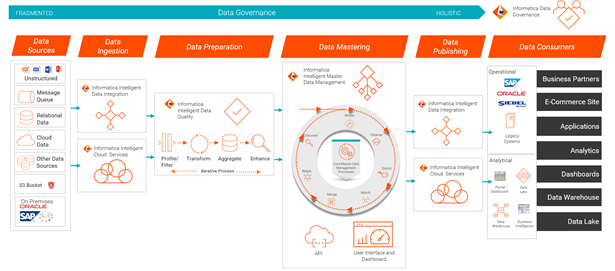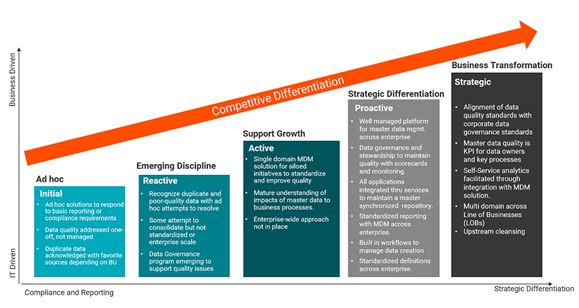7 Common Pitfalls to Avoid While Managing 360 Views of Your Business Data
“Everything I know now . . . the pitfalls, the highs and lows, everything . . . it taught me and made stronger” -- Ray Allen
Managing core business entities such as customers, suppliers, products, employees, finance and reference data may seem simple at the outset. However, as the organization scales—and the business processes that rely on this data become more complex as a result—managing master data is anything but easy.
Master Data Management (MDM) helps organizations create trusted views of each data domain, manage relationships between domains, and deliver unique perspectives of the data to various business functions and applications.
The right 360 solution improves organizational effectiveness through customer centricity, cross-sell/up-sell, vendor and employee management, marketing, cost reduction, and compliance management.
But your organization will not realize the true value of master data management cannot if you do not follow the right approach and implementation best practices. In this blog, I’ll cover 7 common pitfalls that organizations often make when implementing MDM and how you can avoid them.
1. MDM is seen as yet another technology project
Approaching MDM implementations as another technology project with very limited or no business stakeholder involvement is one of the biggest mistakes an organization can make. True capabilities and features in MDM roadmap can only be realized when business stakeholders are actively involved throughout.
MDM is meant to improve existing business operations, realize cost savings, optimize processes, deliver precise business analytics, and streamline mergers and acquisitions. Active collaboration with various business team expands the 360-journey vision and scope of the implementation.

Without active involvement, the solution will not be solving the right business problem. This often results in an implementation that fails to deliver business value, which translates into poor adoption and a loss of confidence in 360 solutions.
De-duplication and data quality improvements are not everything in 360 implementations, as they are usually part of a solution for a much broader business problem. However, core data problems can persist if the business is not ready to adopt the MDM solution in the broader ecosystem of business processes. It is very important to align the vision across all business operations, marketing, sales, and other divisions.
2. Internal resistance on changing business processes
“The secret of change is to focus all of your energy not on fighting the old, but on building the new” -- Socrates
Fear of losing control and getting too comfortable with existing business processes is a major hindrance for success with MDM implementations.
The real value of MDM can be realized once overall business processes related to core business entities (such as customers, products, employees, vendors/suppliers) also changes along with core MDM implementations.
It requires significant changes how an organization typically manages core business elements prior to any MDM initiative. In many instances, successful implementation of MDM demands that you move core business elements to a centralized repository instead of creating and maintaining the same information across multiple sources and business units. Even if existing CRM, ERP, or other business applications create and manage similar information, by incorporating data quality improvements at first data entry point and addressing key functionalities such as search before creating, you can resolve duplicates prior to creation and avoid major rework on removing duplicates or junk data elements later.

To learn more about how to overcome resistance to change, see this Harvard Business Review article by Sally Blount and Shana Carroll.
3. Try to Implement Overall 360 Solution in First Phase
“Great things are not done by impulse, but by a series of small things brought together.” --Vincent Van Gogh
Many organizations would like to implement end-to-end master data solutions in a first phase, for a variety of reasons, such as the desire to show a quick return on investment, to ramp up improvements to business processes, or to achieve rapid and more accurate 360⁰ views of critical business elements.
Unfortunately, this approach often leads to disaster or outright program failure due to multiple factors, such as a failure to analyze the impact of external dependencies, inadequate release planning, insufficient change management, lack of alignment for master data governance with business intelligence and analytics initiatives. Failing to plan is ultimately counter-productive and will end up taking more time than a gradual approach.
With a gradual MDM implementation, you are able to carefully analyze the results of each previous phase before you embark on your next step. This allows you to avoid or course correct for any mistakes in earlier phases that would otherwise impact subsequent phases (and become harder to correct over time).
By starting with a manageable scope and removing dependencies, you are able to show a quick deployment of MDM as a Minimally Viable Solution (MVS). With its focus on showcasing solution capabilities, this MVS approach should act as discussion starter towards broader organizational alignment for MDM adoption. Here is an example of a step-by-step milestone-based approach.

4. Blurred vision defining purpose of MDM
It is very critical to know the purpose for your MDM solution. By not knowing whether MDM will be used for operational or analytical purposes (or both), you will create ambiguity in business process definitions, as well as impede integration with external applications.
Analytical solutions are primarily focused on how to measure the business, by combining master data and its underlying transactions along with the data lake/ warehouse that supports business intelligence applications.
Operational solutions focus primarily on how to support the day-to-day operation of the business processes, upstream of the business transaction, at source, where the data is originally authored.
Unclear vision on core purpose of MDM can lead into faulty processes, unrealistic expectations for the solution, and eventually an overall program failure.
Organizations should consider whether they are choosing either or both styles of MDM to define purpose and vision of MDM within the organization. Though both styles have their own merits, an operational solution has a few more risks as compared to an analytical solution.
Most organizations achieve the greatest benefit by starting with analytical MDM and then move towards an operational solution at a later stage.
5. Considering Implementation as One-time Activity
“The designer does not, as a rule, begin with some preconceived idea. Rather, the idea is (or should be) the result of careful study and observation, and the design a product of that idea.” – Paul Rand
As part of MDM planning and roadmap definition, assuming implementation as one-time activity is another potential pitfall.
To establish a single version of truth requires constant reviews related to how data changes over time, whether by source or applications. After the initial implementation, business, cleansing, and matching rules will require tuning and enhancements.
Data strategy should focus on an iterative process of deriving improved matching techniques, new link or relationships through semantic knowledge graphs which can provide interesting insight about customer relationships, company information, supplier background, and other data sources.
6. Putting the cart before the horse
Another common mistake of MDM implementation solution is failing to follow the correct order. Trying to implement MDM without following the right order potentially risks the overall initiative, and wastes money, energy, and time.
Unless core data elements are cleansed, standardized, even best match rules cannot produce best version of truth. Unless proper governing processes are in place, highly standardized data can eventually become unreliable.
MDM implementation should start with a clear vision that aligns with organizational business priorities. A clear and correct order includes necessary business requirements, conceptual data model, and identifies a team of internal data management champions.
By not following the right order, you risk not only stalling the journey, but can create significant dissatisfaction, demotivation, and frustration for your team and major stakeholders.
The following reference architecture shows critical steps for building a successful MDM solution.

7. Under- or Over-Estimating Existing Capabilities
When it comes to 360 implementation capabilities, not every organization is at the same level of maturity. Some organizations may be at the beginner level of supporting ad-hoc quality requirements, while others are able to understand the issues and can resolve them on a reactive basis.
The best approach to MDM implementation will vary, and it should be based on your organization’s existing capabilities. There are many examples where organizations failed to correctly estimate their existing capabilities. MDM implementations are a little more complex than CRM and ERP implementations—don’t make the mistake of underestimating the actual amount of work and timeline your implementation will require. By realistically assessing your existing capabilities and leveraging your current state of maturity, you will significantly improve your time to market for your MDM solution. The following figure illustrates how an organization’s maturity level rises with successful MDM iterations.
Summary
Avoiding mistakes in your MDM implementation is very important to avoid budget overruns, project delays or losing the confidence for your key stakeholders or sponsors. Due to the nature of iterative process of core functionalities like matching and consolidation, it may take some time for your organization to realize the value of your MDM solution. But when it is done correctly, MDM solutions create a strong foundation towards any organizational data-driven journey.
The one common platform of Informatica Intelligent Data Management Cloud™ helps to accelerate your solution journey through simplicity, productivity and scale. Along with Informatica’s CLAIRE AI engine for master data management—and avoiding these common pitfalls—the return on investment can be exponential.








